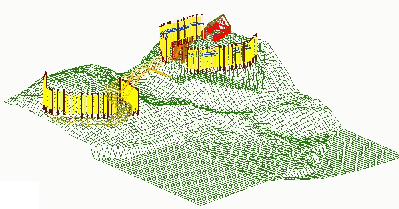Using a modular methodology such as this results in a much more flexible approach to the modelling process. As the structural elements are defined programmatically (in the form of AutoLISP routines in this case), changes to the parameters enable easy modification of the model, and encourages experimentation and the presentation of alternative hypotheses. It should be emphasised that while this methodology was being developed the parameters were hard-coded into the routines, but adding a user-friendly front-end is a trivial task. This component approach can be developed to the point where a complete model can be represented by the programmatic instructions for the reconstruction of the individual structural components or collections of components, and the relevant user-provided parameters (location, scale, etc.). In the case of Symon's Castle, the initial model consists solely of the topography, and the palisades, wall-walks, bridge, roadway, tower, and hall can all be added with only the definition of a limited set of required parameters. Since the physical reconstruction of each individual element is not required, this greatly enhances the experimental potential by simplifying the overall modelling process.

©Internet Archaeology
Last updated: Mon 19 June 2000
URL: http://intarch.ac.uk/journal/issue8/huggett/jhproc3.html